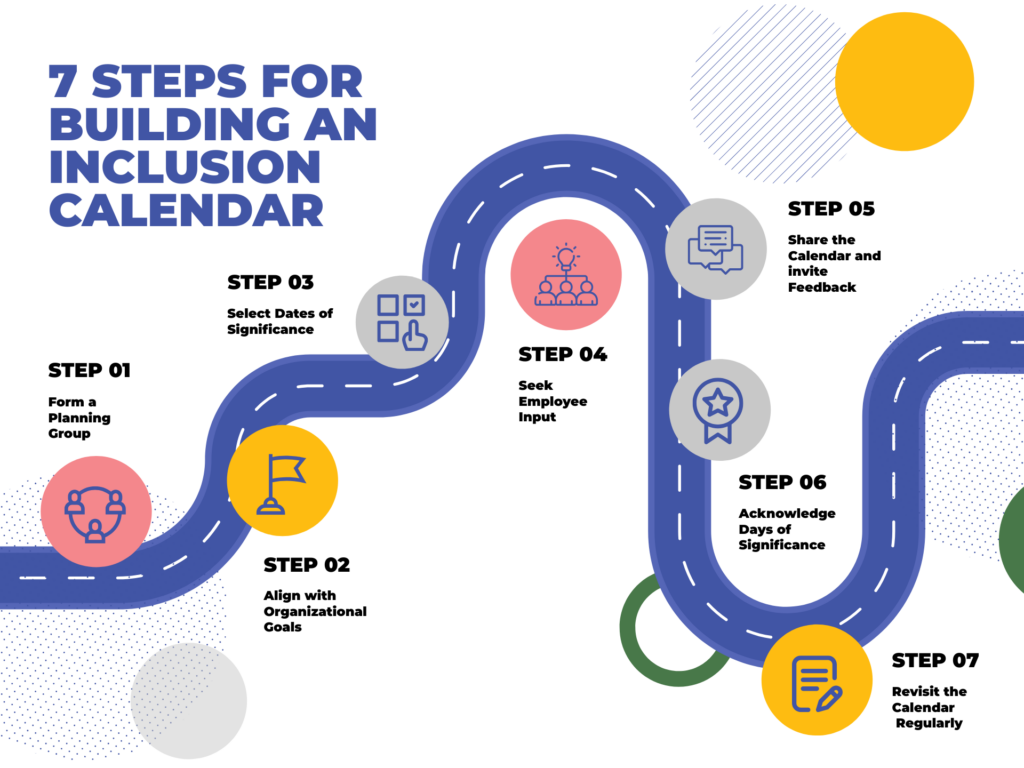“Being safe is about being seen and heard and allowed to be who you are.”
– Dr. Rachel Naiomi Remen.
In the workplace, “being safe” – creating a safe, inclusive culture – means knowing your employees and finding ways to connect with them about what’s meaningful in their lives.
To this end, many organizations are creating inclusion calendars.
An inclusion calendar is a living document that marks days of significance, recognition, and celebration for people of diverse identities and backgrounds. It helps employees understand one another and promotes the recognition and appreciation of diverse social groups within the organization.
But how do organizations actually create these calendars? What processes do they need to set up? Who should be included? How do they decide what dates to put on a calendar?
On May 9, Inclusivity’s CEO Wyle Baoween worked with HR expert Sarah Hamelin to host a webinar: “Building Inclusion Calendars: Where to Start and What to Include.” The webinar was based on Inclusivity’s most recent guide, Building an Inclusion Calendar, and outlined basic principles and seven general steps. (The full webinar video, presentation, and link to the guide are available below.)

Throughout the presentation and discussion, participants asked about common pitfalls and challenges. Here, based on this conversation, we describe six common mistakes organizations make when trying to build inclusion calendars.
Six Common Pitfalls
1. Lacking strategy: “This calendar is not driving EDI in the company,” said Hamielin. “It should be part of the broader commitment and strategy.” An inclusion calendar is not a standalone project – it needs to be part of a broader EDI approach. Only with a clear sense of the calendar’s purpose within the specific needs and EDI strategy of an organization will you be able to communicate about the calendar effectively and make decisions about what dates to include and how to mark or commemorate them.
2. Failing to involve leadership: Hamelin noted that senior leaders need to be involved in the development of the guide – not as sponsors, at arms-length, but as part of the ongoing dialogue. Participants agreed: ”If leadership is not involved, the calendar becomes performative,” said one.
3. Burdening marginalized employees with the work: Do not ask equity-seeking groups to take on additional labour: “It is not their responsibility to explain these things,” Hamelin said. Decisions about equitable distribution of the work depend on the organization, but Hamelin and Baoween, in the webinar, provided just one example. A participant asked if the EDI committee should oversee and manage the calendar; Hamelin and Baoween agreed that while this committee should be consulted and involved, the ownership of the calendar might better lie with teams such as HR, communications or community engagement.
4. Missing knowledge about employees: One participant asked: How can an organization build an inclusion calendar without knowing the identities and priorities of its staff? The short answer, said the facilitators, is that it can’t. “The calendar is the output of understanding your employees,” said Hamelin. Organizations need to do the foundational work of getting to know their employees.
5. Over-promising or failing to manage expectations: The seven steps for creating a calendar involve creating a list of possible dates and then sending it to employees for comments and additions. One potential challenge is that you cannot include all possible events. It is important to tell employees this in advance, when you ask for their input, so that they are not frustrated when their suggested dates do not appear on the calendar. (You might also consider having an internal calendar – within a team or organization – as well as a more external, public-facing one, to accommodate different types of dates of significance.)
6. Expecting perfection: An inclusion calendar is a living document, says Hamelin. “It isn’t going to be perfect, because it will evolve over time, and with understanding.” When you create the initial list, “You will miss things – I guarantee that you will,” said Hamelin. Again, within the seven steps for creating a calendar are many consultative activities and chances for employees to give input. The facilitators also recommend revisiting the calendar regularly, and making changes based on feedback.
Overall, an inclusion calendar is more than just a calendar: it is a site of dialogue and organizational learning.
“You can think of it as a bridge, helping employees understand one another and really amplifying the recognition and appreciation of diverse social groups.”
– Sara Hamelin, Inclusivity
Watch a recoding of the webinar
For help on creating an inclusion calendar, or more information on doing the analytics or strategic planning to build a foundation for your EDI approach broadly, do not hesitate to get in touch at [email protected]






















